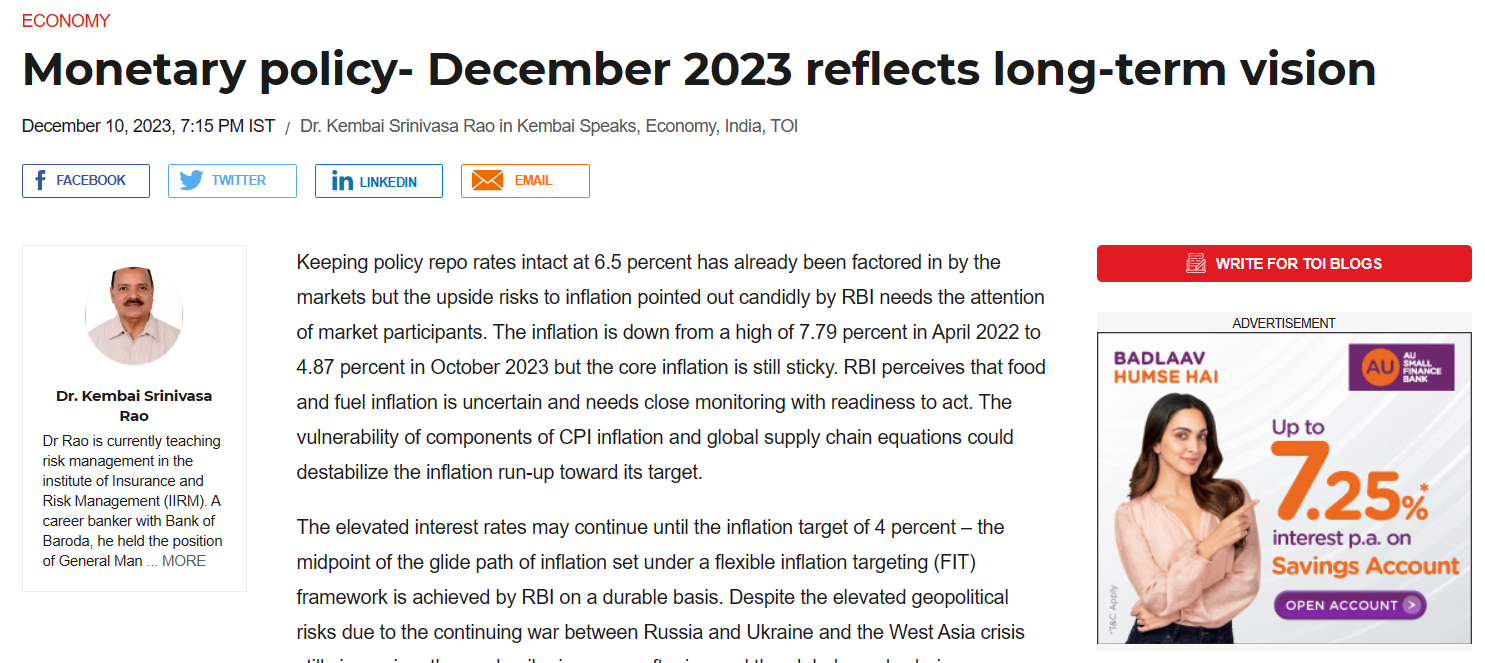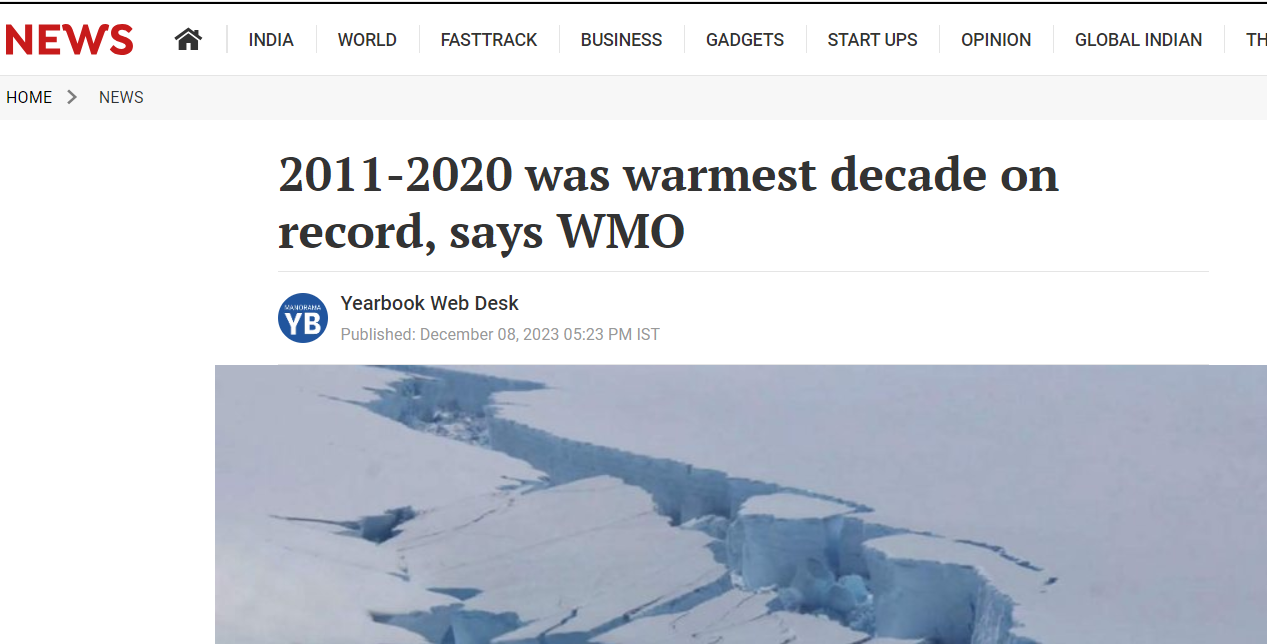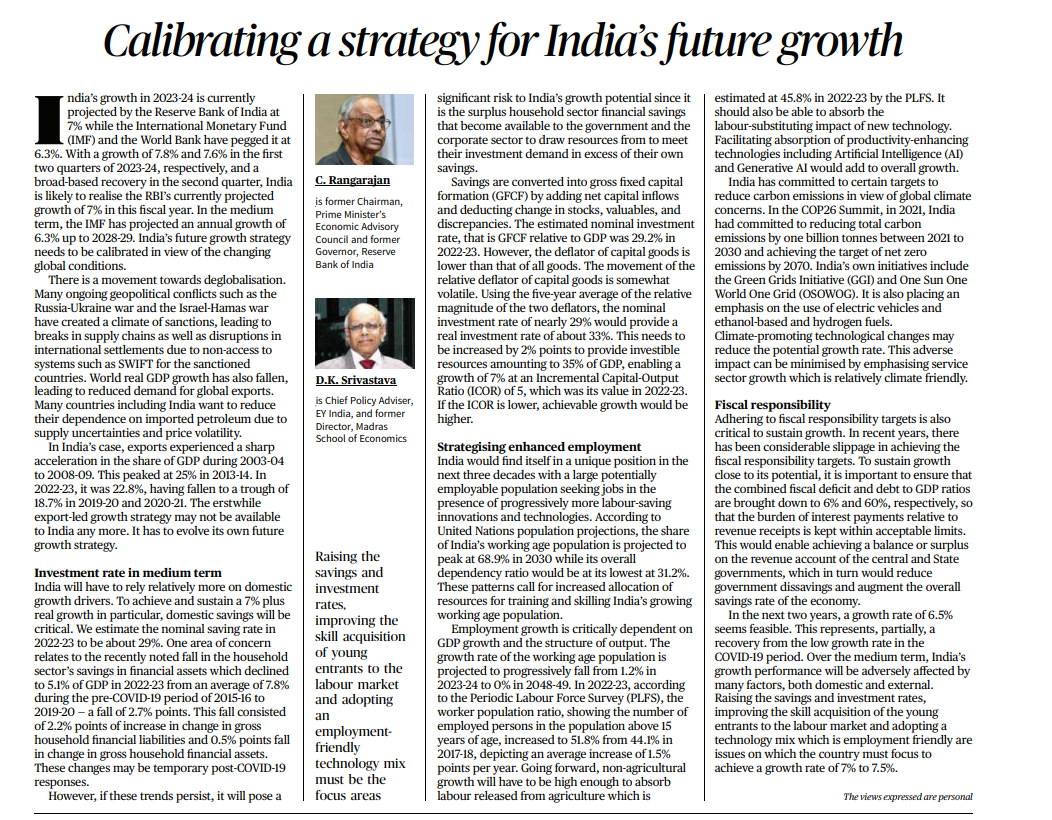Introduction
The recent decision by the Monetary Policy Committee (MPC) to maintain benchmark interest rates at the current level, coupled with an upward adjustment in the full-year GDP growth forecast by 50 basis points, highlights the potential risk of policymakers lagging in their efforts to stabilize inflation expectations.
The committee acknowledges the impact of food price shocks on inflation volatility, signaling a potential challenge in anchoring inflation expectations.
Uncertainties in Food Prices
- The MPC recognizes the likelihood of headline inflation accelerating in November-December due to uncertainties in food prices and unfavorable base effects.
- Despite acknowledging that recurring food price shocks are hindering the ongoing disinflation process, the committee has chosen to keep the RBI’s repo rate unchanged at 6.5% for the fifth consecutive bi-monthly meeting.
- Although retail inflation has moderated since the October meeting, the MPC anticipates a resurgence in price gains in the coming months, compounded by volatility in oil prices and financial markets amid global uncertainties.
Monetary Policy Committee (MPC)
The establishment of a statutory and institutionalized framework for a Monetary Policy Committee (MPC) was introduced through an amendment to the Reserve Bank of India Act, 1934, by the Finance Act of 2016.
In accordance with Section 45ZB of the amended RBI Act, 1934, the central government has the authority to form a six-member MPC. The primary responsibility of the MPC is to determine the benchmark policy rate, or repo rate, aimed at maintaining inflation within the specified target range.
The composition of the MPC includes six members: the RBI Governor serves as the Chairperson, the RBI Deputy Governor responsible for monetary policy, one official nominated by the RBI Board, and the remaining three members representing the Government of India.
The tenure of external members within the MPC is four years.
Households’ Inflation Expectations Survey
- The recent ‘Households’ Inflation Expectations Survey’ conducted by the RBI in November indicates that most households expect faster inflation in the three-months-ahead and one-year-ahead timeframes.
- Median expectations stand at 9.1% and 10.1%, respectively, emphasizing that inflation expectations are still not durably anchored.
Upgrading GDP Growth Projection
- The MPC’s decision to upgrade the projection for real GDP growth in the fiscal year ending March 2024 to 7%, up from 6.5% in October, presents a dissonance in messaging.
- The committee attributes this adjustment to robust investment, ongoing strengthening in manufacturing, buoyancy in construction, and a gradual rural recovery, potentially brightening prospects for household consumption.
- However, the sustained 6.5% repo rate, despite a cumulative 250 basis points increase since May 2022, suggests that consumption struggles to gain traction, possibly due to high inflation discouraging discretionary spending, as noted by Deputy Governor Michael D. Patra.
Conclusion
The disparity in the MPC’s messaging, coupled with negative consumer sentiments on current and future price conditions revealed in the November ‘Consumer Confidence Survey,’ underscores the challenge of achieving price stability.
Policymakers are acutely aware that without price stability, the benefits of expanding GDP and employment may be undermined by the erosion of purchasing power. The MPC faces the crucial task of navigating these challenges to ensure economic stability.
The Global Climate 2011-2020 Report
https://www.onmanorama.com/news/world/2023/12/08/2011-2020-warmest-decade-on-record-says-wmo.html
Context:
The severity of the climate crisis is starkly reflected in the state of glaciers, integral components of the cryosphere. The World Meteorological Organization’s recent publication, “The Global Climate 2011-2020,” presents a thorough overview of Earth’s response to greenhouse gas emissions.
About Glaciers:
- A glacier is an extensive, perennial accumulation of crystalline ice, snow, rock, sediment, and water originating on land, descending downhill under its own weight and gravity.
- Glaciers account for 2.1% of Earth’s total water, with 97.2% found in oceans and inland seas.
- Conditions conducive to glacier formation include mean annual temperatures near freezing, substantial snow accumulations from winter precipitation, and year-round temperatures that prevent the complete loss of the previous winter’s snow accumulation.
- The glacier formation process starts where annual snowfall surpasses melting. Fresh snow compacts over time, densifying in a process called firnification.
- At around 50 meters (160 feet) thickness, firn grains merge into a solid ice mass, initiating glacier movement due to its weight. Different glacier sections move at varying speeds, with the middle flowing faster than the base.
- Geographically, 91% of glaciers are in Antarctica, and 8% are in Greenland, collectively covering about 10% of the world’s land area.
The Global Climate 2011-2020:
- In the section on glacier health, the report notes that, on average, global glaciers experienced an annual thinning of around one meter from 2011 to 2020.
- Despite regional variations, the overarching trend persists: glaciers globally are diminishing in size.
- Some crucial glaciers have already disappeared due to complete melting of winter snow during summer, with projections that glaciers on Africa’s Rwenzori Mountains, Mount Kenya, and Kilimanjaro will vanish by specified years.
- The report emphasizes the rapid expansion of pro-glacial lakes, increasing the risk of glacier lake outburst floods (GLOF) with detrimental impacts on ecosystems and livelihoods.
Recent Instances:
- This year, the Chungthang dam in Sikkim was destroyed by a Glacier Lake Outburst Flood (GLOF) after the flooding of South Lhonak Lake from a melting glacier, causing downstream catastrophe.
- Another report by the International Centre for Integrated Mountain Development revealed that glaciers in the Hindu Kush Himalayas disappeared 65% faster in the 2010s than in the previous decade.
Crucial Steps:
- Considering the anticipated rise in global greenhouse gas emissions, projected to increase temperatures by 2.5°3°C by the century’s end, glacier volume is expected to decline between 55% and 75%.
- This foretells significant reductions in freshwater supply by around 2050. The vulnerability of glacier systems underscores the urgent need for vigilant monitoring.
- Despite awareness of risks posed by Himalayan glaciers, there is currently no early warning system for GLOF events.
- Authorities must elevate the threats associated with diminishing glaciers to the same level of risk as alerts issued for cyclones, floods, and earthquakes.
Conclusion:
There is an urgent need for comprehensive risk assessments, mapping of vulnerable regions, and the initiation of infrastructure development adhering to the highest standards of care to effectively address the risks posed by diminishing glaciers.
India's Economic Growth Projection
Overview
India’s economic growth for the fiscal year 2023-24 is forecasted at 7% by the Reserve Bank of India (RBI), while the International Monetary Fund (IMF) and the World Bank estimate it at 6.3%. The initial two quarters of 2023-24 witnessed growth rates of 7.8% and 7.6%, signaling a promising trend.
Global Context
- Deglobalisation Trends
– Ongoing geopolitical conflicts (e.g., Russia-Ukraine, Israel-Hamas) contribute to a movement towards deglobalization.
– Sanctions and disruptions in international settlements impact supply chains.
– Global real GDP growth decline affects global export demand.
- Petroleum Dependency
– Countries, including India, seek to reduce reliance on imported petroleum due to supply uncertainties and price volatility.
Export-Led Growth Challenges
India’s historical export-led growth strategy faces challenges, as the share of exports in GDP declined to 22.8% in 2022-23, prompting the need for a recalibrated growth strategy.
Investment and Savings
- Domestic Growth Drivers
– India needs to rely more on domestic growth drivers to sustain a 7% real growth rate.
– Domestic savings, critical for growth, are estimated at 29% in 2022-23.
- Concerns About Household Savings
– The household sector’s savings in financial assets fell to 5.1% of GDP in 2022-23, posing a risk to India’s growth potential.
- Investment Rate
– Nominal investment rate was 29.2% in 2022-23, requiring an increase to 35% for a 7% growth, considering Incremental Capital-Output Ratio (ICOR).
Employment Strategies
- Unique Demographic Challenge
– India faces a unique situation with a potentially employable population amidst labor-saving innovations.
– Increased allocation for training and skilling is necessary.
- Working Age Population Dynamics
– The working age population is projected to peak at 68.9% in 2030.
– Non-agricultural growth must absorb labor released from agriculture and accommodate technological advancements.
Climate Concerns
India commits to carbon emission reduction targets and emphasizes climate-friendly technological changes, balancing growth with environmental sustainability.
Fiscal Responsibility
Adherence to fiscal responsibility targets is crucial for sustained growth. Achieving a combined fiscal deficit and debt to GDP ratios of 6% and 60%, respectively, is essential.
Medium-Term Outlook
Over the medium term, India’s growth may face challenges. To achieve a growth rate of 7% to 7.5%, the focus should be on raising savings and investment rates, enhancing skill acquisition, and adopting employment-friendly technologies.




